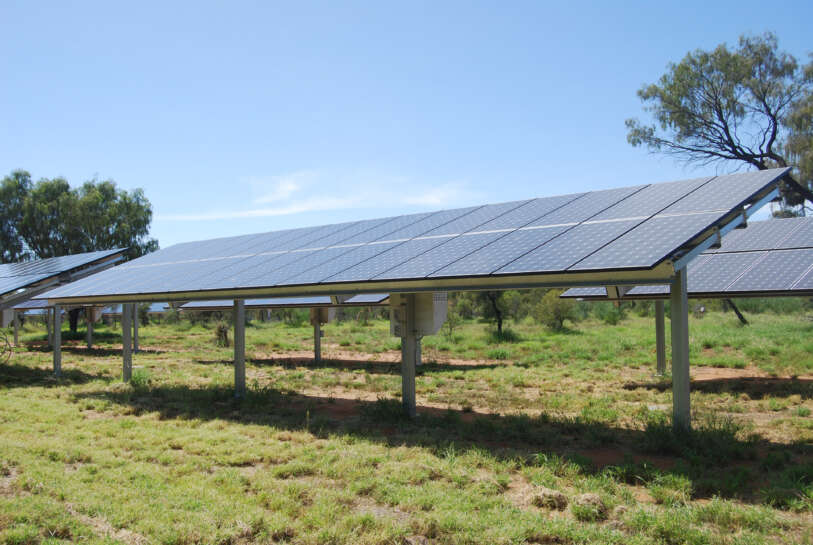| Manufacturer | Sanyo |
|---|---|
| Array Rating | 6.3kW |
| PV Technology | Other |
| Array Structure | Fixed: Ground Mount |
| Installed | 2010 |
View on Map Graphs Download Data
Current Output

HIT hybrid silicon array, fixed ground-mount.
HIT (Heterojunction with Intrinsic Thin Layer) hybrid solar technologies combine different types of photovoltaic materials to increase the spectrum of the sunlight received by panels being converted to electricity.
The cells in the Sanyo HIT panels are constructed of a thin layer of crystalline silicon between two layers of amorphous silicon. The different photovoltaic materials are used together in this way to increase the overall efficiency of the solar cells.
This demonstration array will evaluate the performance of hybrid solar technology in high temperature environments
Sanyo panels are supplied in Australia by Apollo Energy. Apollo Energy is a provider of small to medium-scale, grid-connected renewable energy systems.
| Array Rating | 6.3kW |
|---|---|
| Panel Rating | 210W |
| Number Of Panels | 30 |
| Panel Type | Sanyo HIP-210NKHE5 |
| Array Area | 37.83 m² |
| Type Of Tracker | N/A |
| Inverter Size / Type | 7 kW, SMA SMC 7000TL |
| Installation Completed | Thu, 11 Mar 2010 |
| Array Tilt/Azimuth | Tilt = 20, Azi = 0 (Solar North) |

Notes on the Data
-
Site 17: Inverter Replacement
This system received a new SMA SMC 6000A inverter following failure of the previous inverter. The new inverter went online at around 10.45am on Thursday, 9 May 2019.
-
Site 17: Inverter Troubleshooting and Historical Correction
Low levels of generation from 12 December 2018 have been noted and troubleshooting suggests an inverter issue, which is continuing to be investigated.
During the course of investigations, it was noticed that the inverter model of this array, as previously published on the website, had not been accurately recorded. The correct inverter model is an SMA SMC 6000A installed in July 2013, not an SMA SMC 7000TL. Any inconvenience caused is regretted.
-
System Disconnection for Cabling Works
All arrays at the Solar Centre were disconnected from approximately 2.00pm to 3.00pm on Monday, 9 July 2018 in preparation for the cable between the main switchboard and distribution board being upgraded. Array sites #23-38 remained disconnected while the main feeder cable to these sites was replaced in subsequent days, but all systems were re-connected by early afternoon on Thursday, 12 July 2018.
-
Monitoring Interruption for UPS Battery Replacement
The disconnection and re-connection of the solar arrays and weather station equipment while a new site connection was being established prompted the already flattening UPS batteries which power the site’s energy meters to fail and require immediate replacement. Data recording was affected from approximately 2.30pm ACST, Monday 10 July to 4.00pm, Wednesday 12 July.
Affects weather data for DKASC, Alice Springs
-
System Outage - Sites 4, 5, 17, 20, 22, 34 and 35
On the 5th June 2015, A Friday before a long weekend, seven individual PV systems at the DKASC were switched off by unknown persons and for unknown reasons. The outage was not noted until the following Tuesday when O&M staff returned to work and found the main circuit breakers for sites 4, 5, 17, 20, 22, 34 & 35. turned off. These systems were all turned back on again on the 9th March when the problem was detected.
> Answer to Spotlight Question
Onsite at the DKA Solar Centre in Alice Springs are a series of quiz-like Spotlight Questions at each array. Visit the centre and scan the QR code at each sign to test your knowledge – and check your answer here!
Q: What differences in appearance can you see compared to other thin film modules?
A: While the layers of a HIT module comprise both monocrystalline silicon and amorphous silicon, the overall module is structured like a crystalline module, that is, sectioned into square-like cells with conductors running across them. Therefore, from the outside, they resemble a typical monocrystalline module even though the monocrystalline layer is actually in the middle of the "sandwich". The structure of a regular thin film module is different to this as their cells are long and very close together, with electrical contacts etched into the reverse side and no use of bypass diodes to protect against reverse current flows; the result is a surface that looks clear, smooth and even, rather than segmented like the crystalline cell layout.
